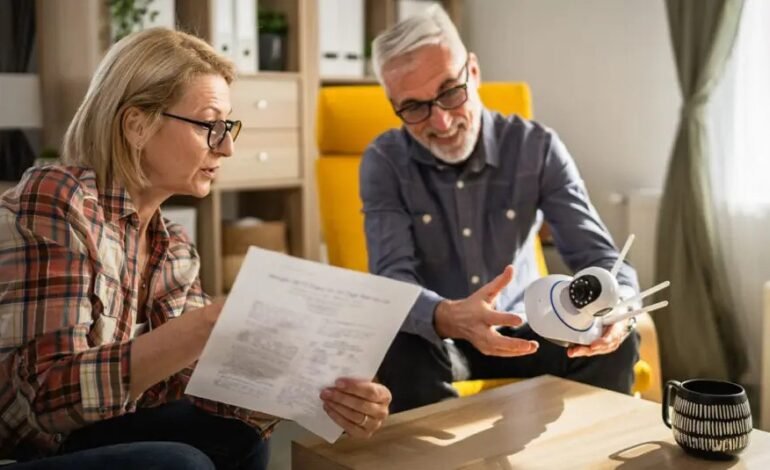
Top Tips for Selecting the Perfect Home Security Camera
- What can a home security camera do?
- Is it better to have wired or wireless security cameras?
- Do I need Wi-Fi for home security cameras?
- How do I determine how many security cameras I need at home?
- Choosing the right types of home security cameras
- What’s the difference between home surveillance cameras and security cameras?
- Features to look for when purchasing home security cameras
- Are home security cameras worth It?
While smart home security cameras might seem like you’re inviting Big Brother into your home, they can keep your property safe and discourage intruders. If you’re considering increasing security measures at home, installing a camera system is an excellent step. Choosing the right one can be challenging, however, given the numerous options available. Rest assured, this guide will help you find a security camera solution that suits your specific needs.
What can a home security camera do?
Home security cameras come with plenty of great features. Smartphone apps can connect to your device, providing home monitoring from anywhere. Even when you’re inside your home, you can be alerted to unusual activity outside—like those parcel porch thieves! They can detect sound and movement at any time, as many have night vision capability. They’ll also record footage for you to review later or, if needed, provide as evidence to the police.
Is it better to have wired or wireless security cameras?
This depends entirely on your needs. Wired cameras need a power source and often require professional installation, but they offer reliable, continuous power. On the other hand, wireless cameras are easier to install and move around, but require regular battery changes or recharging. You may also find solar-powered options, but you’ll need to ensure there’s plenty of sun exposure for these to operate.
Do I need Wi-Fi for home security cameras?
Most modern home security cameras use Wi-Fi to connect, so a strong Wi-Fi signal is essential. Some cameras offer cellular or Ethernet connections as backups if your Wi-Fi isn’t strong enough.
How do I determine how many security cameras I need at home?
First, determine whether you want cameras both outside and inside. Consider which areas need monitoring, such as entrances, driveways, backyards and common areas. It’s important to make sure there are no blind spots where intruders could sneak in unnoticed, and also cover indoor areas if they do make it inside.
Choosing the right types of home security cameras
Indoor cameras like the highly rated TP-Link Kasa Cam help keep an eye on areas like living rooms, kids’ playrooms and bedrooms and send instant notifications right to your smartphone. A doorbell camera like the next-gen Ring Video Doorbell 3 has enhanced Wi-Fi and motion detection and is great for watching your front door and interacting with visitors at any time. Outdoor cameras like the TP-Link Outdoor, which has built-in two-way audio and a siren, are built to handle weather and cover large outdoor spaces. Be sure to choose a camera that states it’s for outdoor use—this will ensure it can handle the elements and extreme temperatures.
What’s the difference between home surveillance cameras and security cameras?
Home surveillance cameras are typically used for continuous monitoring and recording, usually in commercial settings. Security cameras, on the other hand, are designed for home use and often include features like motion detection, night vision and remote access via smartphone apps. For home security, you can configure them to record 24/7, only at scheduled times or only when alerts you set are triggered.
Features to look for when purchasing home security cameras
Integration of multiple cameras – Opt for a unified system to manage multiple cameras easily with a single app or hub.
Communication and alerts – Ensure cameras offer smartphone apps for viewing footage and receiving alerts. Consider using your smart hub like Amazon Alexa or Google Home for voice control. Amazon Alexa Show also offers a remote feature where you can view what’s happening when you’re not at home or in a different part of your property.
Privacy and security – For data protection, look for cameras with encryption technology that makes the data that your cameras capture readable only to those who are authorized to view it.
Video quality – Look for cameras with at least 1080p resolution and wide-angle lenses to ensure clear coverage. If the picture isn’t clear, it can’t be enhanced later, if you need a closer look. What you see is what you get.
Automatic updates – Choose cameras with automatic firmware updates for the latest features and security patches. (And be sure to use strong passwords or a password manager!)
Advanced features – Cameras with AI can distinguish between people, animals and vehicles and reduce false alarms. You don’t want to be alerted every time a possum happens to investigate your back door. Smart alerts notify you of significant events.
Night vision – Ensure cameras have infrared LEDs for clear visibility in complete darkness. Advanced sensors improve performance in low-light conditions.
Smart home integration – Select cameras that can integrate with other smart devices for centralized control. Dedicated apps simplify management and monitoring.
Are home security cameras worth It?
Home security cameras a great component of a whole smart home system that integrates with smart lighting, speakers, temperature controls and detectors. Security cameras can help provide peace of mind—and that alone makes them a worthwhile investment.




